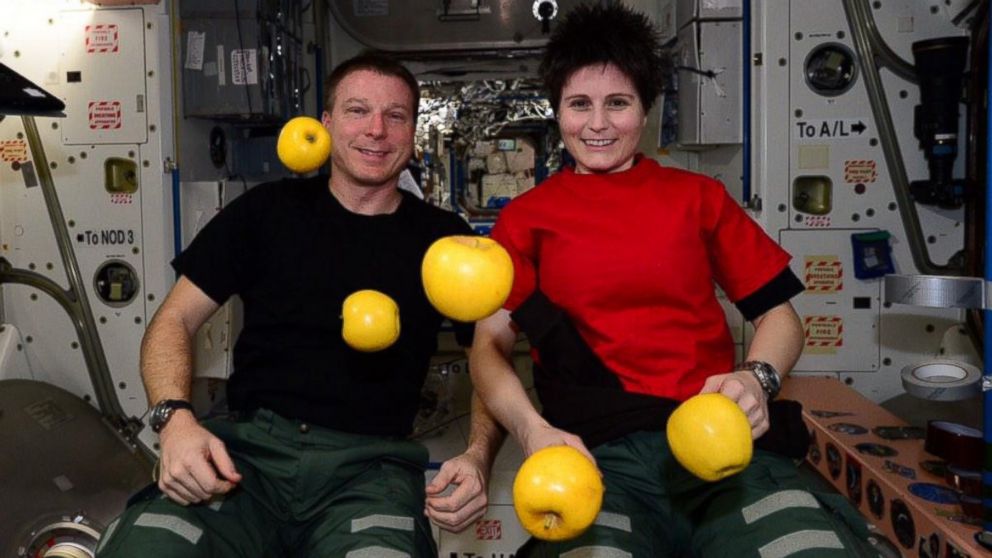
Every year, more than one million apple trees of apple varieties developed by breeders from the Institute of Experimental Botany of the CAS (IEB) are sold worldwide. However, only the Opal® variety has managed to travel into space. You read that correctly. In 2015, NASA sent the fruits of the variety to astronauts on the International Space Station (ISS). This is confirmed by a photo in which US astronaut Terry Virts, along with fellow Italian Samantha Cristoforetti, pose with fresh apples floating in weightlessness.

Questions are answered byIng. Radek Černý, PhD., head of the scientific group.
You have been a direct participant in the story of the market application of the Opal® variety, what did it teach you?
I have been actively involved in the successful transfer, leading to the current global application of the variety, under the guidance of the world-famous breeder, Dr. Jaroslav Tupý, since 2009 – symbolically in the year of the first commercial sale of the then newly launched variety on the market. With hindsight, I can happily say that I had the honour of being in the right place at the right time. It was the best school for me in terms of securing intellectual property protection, drafting licensing agreements and fostering research and especially commercial links.
Opal® is now registered in more than 40 countries and under the leadership of its licensing partners, Varieties International, LLC, USA and Fruit.select GmbH, Germany, is finding significant application in warm growing areas supplemented by drip irrigation, especially in the USA, Europe, but also in South Africa, Chile and Australia. The variety is grown as a ‘club’ variety for cultivation exclusively by selected world growers. In the last decade, nearly 2.5 million Opal® trees have been planted worldwide. The apple tree breeding programme of the IEB is further co-financed by the licensing income generated from the sale of trees and the marketing of the fruit.
What are the pitfalls of transferring research results in your field of work?
After more than 60 years of apple breeding and 30 years of experience in commercializing the results, the apple breeding program of the IEB has a very extensive network of business partners from nurseries, growers, research institutes and marketing companies with a wide global presence. However, a good premise for the implementation of results into practice carries some inherent or specific risks. These include the possibility of a different degree of expression of the relevant varietal trait when the selected new breeding is tested on the site of a potential trading partner with often very different soil, temperature and rainfall conditions, the occurrence of a not infrequently different range of diseases and pests, or different consumer preferences, both in positive and negative degrees of expression. The breeder must accept the results of trials of a given variety with respect, humility and gratitude, because it is always a valuable experience that can be used for further breeding.
The natural challenge of transferring new apple varieties into practice is the huge competition in the market, corresponding to the fact that apples are the 3rd most cultivated fruit species in the world, the most cultivated in the temperate zone and the 8th most cultivated crop in the world. Thus, breeding a new promising apple variety is “only” the first prerequisite for a successful transfer of the result. It is also necessary to find a suitable business partner, to secure intellectual property protection for the variety by obtaining national or European breeding certificates or plant patents, and to make the variety available by granting licensing rights for propagation and sale of trees or trading the fruit in the country concerned or for global application. In this respect, the IEB apple breeding station has a very sophisticated know-how, which provides a prerequisite for high competitiveness of new varieties on the Czech and global market. The high ability to transfer the results into practice is evidenced by the annual worldwide sales of 1.35 million trees of the IEB apple varieties, representing the good name of Czech science and research.
What role do consumer preferences play in your work?
Consumer preferences significantly influence the practical applicability of a new variety. They are not only related to taste, but also to appearance, fruit size and flesh consistency.
Preferences are usually conditioned by region – geography and also by the age structure of the consumers. In countries further away from the equator, the more tart taste of apples is slightly preferred, giving a fresh, refreshing impression in the mouth, while in countries with warmer climates, on the other hand, the sweet to very sweet taste is more strongly preferred. Of course, exceptions among consumers confirm these generalised assumptions. A number of consumption tests have confirmed that the preference for sweeter apples prevails among young and, conversely, older consumers, while the demand for sweet to tart apples is slightly more prevalent among the middle-aged category.
In Italy, generally known as the land of fashion, apple varieties with very attractive fruit are particularly favoured. In the countries with the most advanced organic fruit growing, such as Germany and Austria, even moderately attractive varieties of highly resistant fruit are generally accepted on the market, with the emphasis on the production of healthy fruit grown without pesticide treatments. In the developed countries of Europe and the USA, the most sought-after fruits are those with a size, or more precisely a transverse diameter, of 70-85 mm. At the same time, in eastern countries, particularly Russia, there is a strong demand for fruit 80 mm and larger.
Although the apple tree is a fruit species that produces a wide range of colours from green, yellow, orange, pink, red to very dark shades, in general the most desirable apples in the world are of an intense red colour, preferably all over. The global use of the deep yellow Opal® variety has been even more successful. The excellent marketing strategy of the IEB’s licensing partner, Varieties International, USA, which deliberately marketed Opal® not as yellow but as golden, so that it would not be compared too closely with one of the most widely grown varieties, Golden Delicious, played a role in this. In two marketing studies carried out in 2009 in Chicago and Washington among 1 000 consumers, Opal® was rated as excellent, with 89 % of consumers being very impressed by Opal® and 63 % preferring the taste of Opal® to that of their previously preferred variety. Today, Opal® is slowly replacing the traditional and very popular Golden Delicious variety, especially in the US market.
In recent years, the trend has been towards a very crisp, melt-in-the-mouth consistency of the flesh, combined with high juiciness and a thin, virtually imperceptible skin. The breeder’s aim is to give the consumer an intense experience of all his senses when eating apples – to impress the eye with the attractiveness of the fruit, to smell the pleasant aroma, to hear the crisp, crunchy flesh when cutting or biting into the apple and to enhance the overall impression with an excellent, fully aromatic taste.
What are you working on now?
Our current primary objective is to breed new apple varieties with permanent resistance to the most important diseases in combination with good growing and economic characteristics. The most important apple tree diseases are scab, apple scab and bacterial scab. In terms of economic characteristics, several dozen traits and characteristics are evaluated, the most important being good growth characteristics, high disease resistance, high and regular yields, attractive, very tasty fruit and long shelf life.
In addition to eating apple varieties, for almost 30 years we have been breeding apple varieties with narrow columnar growth, which are mainly used in home gardens. Annually, around 70,000 trees of columnar varieties from the IEB are sold in selected countries in Europe and the USA. Considering that they are mostly sold individually for home gardens, this result is also a great advertisement in tens of thousands of home gardens. Another breeding target is ornamental apple varieties with a columnar growth type for pollination purposes in intensive apple plantings. We are also breeding red-fleshed apple varieties to expand the already diverse range of apple varieties that appeal to the most demanding consumers.
Thank you for the interview.
An interesting article about Opal® apples can also be found in the popularization magazine Omega.




